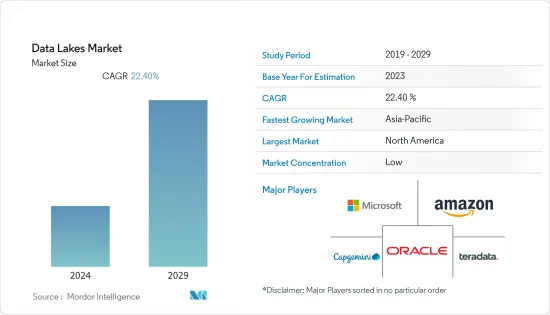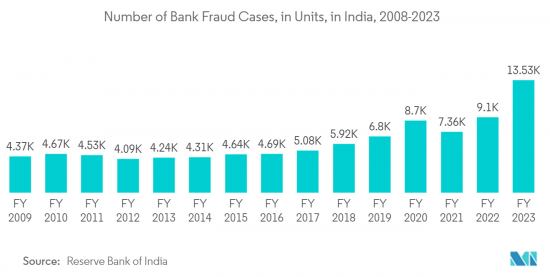 |
市场调查报告书
商品编码
1404392
资料湖 -市场占有率分析、产业趋势/统计、2024 年至 2029 年成长预测Data Lakes - Market Share Analysis, Industry Trends & Statistics, Growth Forecasts 2024 - 2029 |
||||||
※ 本网页内容可能与最新版本有所差异。详细情况请与我们联繫。
今年资料湖市场规模预估为111.4亿美元,复合年增长率为22.4%,预计五年后将达377.6亿美元。
资料湖是一个中央储存库,存储大量资料、结构化、半结构化和非结构化资料,资料希望从资料中获取有价值资料的组织而言,它是宝贵的资产。

主要亮点
- 巨量资料的兴起和对高级分析解决方案的需求增加了对资料湖的需求。公司希望有效地储存和处理大量不同的资料。
- 物联网(IoT)的采用导致资料激增是资料湖市场的主要驱动力。物联网设备通常会即时产生大量资料。资料湖可以处理大量资料的涌入,而不会降低效能。
- 资料湖使组织能够利用先进的分析能力,并在当今资料主导的业务形势中获得竞争优势。随着企业不断认识到资料主导洞察的重要性,对具有高级分析功能的资料湖的需求预计将会增长。
- 启动延迟和资料整合挑战是限制市场上资料湖成长和采用的主要因素。将各种来源的资料整合到资料湖中既复杂又耗时。组织可能以不同的格式、资料库和系统储存资料,协调和有效地整合资料需要付出巨大的努力。
- COVID-19大流行加剧了消费行为的变化,包括网路购物、远距学习、虚拟医疗保健和资料产生的增加。资料湖为处理和分析各行业的大量资料流提供了合适的解决方案。
资料湖市场趋势
BFSI 领域的最终用户预计将占据主要市场占有率
- BFSI 部门产生并处理大量资料,包括客户交易资料、帐户资讯、金融市场资料、保险申请和信用评分。资料湖为 BFSI 组织提供了可扩展且灵活的解决方案来管理、处理和分析大量不同的资料。
- 资料湖使 BFSI 组织能够整合和分析多个来源的客户资料,包括银行交易、信用卡使用和线上交易。这种统一的视图可帮助您获得有关客户行为、偏好和需求的宝贵见解,从而促进个人化和有针对性的行销。
- 资料湖是储存各种类型资料的中心位置,例如交易资料、使用者行为模式和历史记录。透过应用先进的分析和机器学习演算法,BFSI 组织可以更有效地侦测和防止诈欺。
- 据印度储备银行称,2023财年,印度储备银行(RBI)报告全印度发生了超过13,000起银行诈骗案件。与上年度相比,这一数字有所增加,扭转了过去十年的趋势。银行诈骗总额从 1.38 兆印度卢比(170 亿美元)下降至 3,020 亿印度卢比(36.8 亿美元)。
- BFSI产业面临信用风险、市场风险、营运风险等多种风险。资料湖使银行和保险公司能够集中和分析风险相关资料,以做出资讯的决策、管理风险并遵守监管要求。
- 许多公司正在推出和开发银行和金融解决方案。 2022 年 9 月,为 Web3 公司创建第一个金融资料湖的 Tres 是一家由 Bold Start Ventures主导、F2、Mantis、New Form、The Chainsmokers、Blockdaemon Ventures、Kenetic 和 Alchemy 等支持的种子公司,宣布其已在第一阶段筹集了760 万美元。

预计北美将占据较大市场占有率
- 北美是采用资料湖的领先地区之一,其推动因素有很多,包括大量精通技术的行业、云端基础设施以及对资料主导决策的高度重视。
- 北美是许多资料密集型行业的所在地,包括 IT、通讯、BFSI、医疗保健、零售和製造。这些行业产生的大量资料正在推动对资料湖作为可扩展且灵活的资料储存和处理解决方案的需求。
- 云端运算将继续存在并被广泛采用。云端基础的资料湖具有众多优势,包括成本效率、可扩展性和易于部署,这使其成为各种规模企业的有吸引力的选择。
- 北美公司是先进分析和人工智慧 (AI) 技术的早期采用者。资料湖透过为大型、多样化的资料集集提供中央储存库,为这些资料驱动的应用程式奠定了基础。
- 物联网 (IoT) 和巨量资料技术的发展正在该地区产生大量不同的资料。资料湖适合处理来自物联网设备和巨量资料来源的复杂且大量的资料。
资料湖产业概况
资料湖市场由 Microsoft Corporation、Amazon.com Inc.、Capgemini SE、Oracle Corporation 和 Teradata Corporation 等主要企业瓜分。市场参与企业正在采取联盟和收购等策略来增强其产品供应并获得永续的竞争优势。
2022 年 10 月,Capgemini SA宣布长期客户Panasonic Automotive Systems将收购其资料生态系统。这个新平台将帮助组织改善资料驱动决策和开发新想法。这使得提取更有效率、可靠。
2022 年 8 月, 资料发布了 VantageCloud Lake,这是一款基于下一代云端原生架构建构的资料产品。 VantageCloud Lake 以资料深厚的历史和专业知识为基础,将 Teradata Vantage 在云端中经过验证的强大功能(称为 VantageCloud Enterprise)引入其核心的云端原生、自动弹性、低成本物件储存中。产品设计为易于使用、易于扩充、易于扩充。
其他福利:
- Excel 格式的市场预测 (ME) 表
- 3 个月分析师支持
目录
第一章简介
- 研究假设和市场定义
- 调查范围
第二章调查方法
第三章执行摘要
第四章市场洞察
- 市场概况
- 产业吸引力-波特五力分析
- 供应商的议价能力
- 买方议价能力
- 新进入者的威胁
- 替代品的威胁
- 竞争公司之间的敌对关係
- 产业价值链分析
- 评估 COVID-19 对产业的影响
第五章市场动态
- 市场驱动因素
- 透过物联网传播资料
- 需要先进的分析能力
- 市场抑制因素
- 资料湖上线和资料整合延迟
第六章市场区隔
- 透过提供
- 解决方案
- 按服务
- 按发展
- 云端基础
- 本地
- 按行业分类
- 资讯科技/通讯
- BFSI
- 医疗保健
- 零售
- 製造业
- 按行业分類的其他最终用户
- 按地区
- 北美洲
- 美国
- 加拿大
- 欧洲
- 英国
- 德国
- 法国
- 义大利
- 欧洲其他地区
- 亚太地区
- 中国
- 日本
- 印度
- 其他亚太地区
- 拉丁美洲
- 墨西哥
- 巴西
- 阿根廷
- 其他拉丁美洲
- 中东/非洲
- 阿拉伯聯合大公国
- 沙乌地阿拉伯
- 南非
- 中东和非洲其他地区
- 北美洲
第七章竞争形势
- 主要供应商概况
- Microsoft Corporation
- Amazon.com Inc.
- Capgemini SE
- Oracle Corporation
- Teradata Corporation
- SAP SE
- IBM Corporation
- Solix Technologies Inc.
- Informatica Corporation
- Dell EMC
- Snowflake Computing Inc.
- Hitachi Data Systems
第八章投资分析
第9章市场的未来

Data Lakes Market was valued at USD 11.14 billion in the current year and is expected to register a CAGR of 22.4%, reaching USD 37.76 billion in five years. A data lake is a central repository that stores large volumes of raw, structured, semi-structured, and unstructured data, making it a valuable asset for organizations seeking to extract valuable insights from their data.
Key Highlights
- The rise of big data and the need for advanced analytics solutions fueled the demand for data lakes. Organizations wanted to store and process vast amounts of diverse data types efficiently.
- The proliferation of data due to adopting the Internet of Things (IoT) has been a significant driver of the data lakes market. IoT devices generate an enormous volume of data, often in real time. Data lakes can handle this massive influx of data without compromising performance.
- Data lakes enable organizations to leverage advanced analytics capabilities and gain a competitive advantage in today's data-driven business landscape. As businesses continue to recognize the importance of data-driven insights, the demand for data lakes with advanced analytics features is expected to grow.
- Slow onboarding and data integration challenges have been significant factors restraining the growth and adoption of data lakes in the market. Integrating data from various sources into a data lake can be complex and time-consuming. Organizations may store data in different formats, databases, and systems, requiring significant effort to harmonize and consolidate the data effectively.
- The COVID-19 pandemic increased the changes in consumer behavior, such as increased online shopping, remote learning, virtual healthcare, and data generation. Data lakes provide suitable solutions for handling and analyzing the massive influx of data across various industries.
Data Lake Market Trends
BFSI End-user Vertical Segment is Expected to Hold Significant Market Share
- The BFSI sector generates and handles vast amounts of data, including customer transaction data, account information, financial market data, insurance claims, credit scores, etc. Data lakes provide BSI organizations with a scalable and flexible solution for managing, processing, and analyzing this massive volume of diverse data.
- Data lakes enable BFSI organizations to consolidate and analyze customer data from multiple sources, such as banking transactions, credit card usage, and online interactions. This consolidated view helps gain valuable insights into customer behavior, preferences, and needs, facilitating personalized, targeted marketing.
- Data lakes are a central repository for diverse data types, including transactional data, user behavior patterns, and historical records. By applying advanced analytics and machine learning algorithms, BFSI organizations can detect and prevent fraudulent activities more effectively.
- According to the Reserve Bank of India, In the financial year 2023, the Reserve Bank of India (RBI) reported more than 13 thousand bank fraud cases across India. This was an increase compared to the previous year and turned around the last decade's trend. The total value of bank frauds decreased from INR 1.38 trillion (USD 0.017 trillion) to INR 302 billion (USD 3.68 billion).
- The BFSI Sector faces various risks, including credit, market, and operational risks. Data lakes allow banks and insurance companies to aggregate and analyze risk-related data to make informed decisions, manage exposures, and comply with regulatory requirements.
- Many companies are launching and developing banking and finance solutions. In September 2022, Tres, the company that made the first financial data lake for Web3 enterprises, announced that it had raised USD 7.6 million in a seed phase led by bold start ventures, with help from F2, Mantis, New Form, The Chainsmokers, Blockdaemon Ventures, Kenetic, and Alchemy.

North America is Expected to Hold Significant Market Share
- North America is one of the leading regions in data lake adoption, driven by various factors, including numerous tech-savy industries, cloud infrastructure, and a strong focus on data-driven decision-making.
- North America has many data-intensive industries, such as information technology, telecom, BFSI, healthcare, retail, and manufacturing. The massive volume of data these industries generate drives the demand for data lakes as a scalable and flexible data storage and processing solution.
- Cloud computing is well-established and widely adopted in this region. Cloud-based data lakes offer numerous advantages, including cost-efficiency, scalability, and ease of implementation, making them an attractive choice for businesses of all sizes.
- North American enterprises have been early adopters of advanced analytics and artificial intelligence (AI) technologies. Data lakes provide a foundation for these data-driven applications by offering a centralized repository for diverse and large datasets.
- The growth of the Internet of Things (IoT) and big data technologies in the region generate massive amounts of diverse data. Data lakes are well suited to handle the complexity and volume of data from IoT devices and big data sources.
Data Lake Industry Overview
The Data Lakes Market is fragmented with major players like Microsoft Corporation, Amazon.com Inc., Capgemini SE, Oracle Corporation, and Teradata Corporation. Players in the market are adopting strategies such as partnerships and acquisitions to enhance their product offerings and gain sustainable competitive advantage.
In October 2022, Capgemini announced that long-time client Panasonic Automotive Systems would get a data ecosystem. The new platform can help an organization improve at making decisions based on data and developing new ideas. This can lead to more efficient and reliable extraction.
In August 2022, Teradata announced VantageCloud Lake, Teradata's product built on a next-generation cloud-native architecture. Based on the deep history and Teradata expertise, VantageCloud Lake can bring the proven power of Teradata Vantage in the cloud, called VantageCloud Enterprise, to an offering that is born in the cloud and designed to be automatically elastic and leverage low-cost object store at its core, easy to use and scale.
Additional Benefits:
- The market estimate (ME) sheet in Excel format
- 3 months of analyst support
TABLE OF CONTENTS
1 INTRODUCTION
- 1.1 Study Assumptions and Market Definition
- 1.2 Scope of the Study
2 RESEARCH METHODOLOGY
3 EXECUTIVE SUMMARY
4 MARKET INSIGHTS
- 4.1 Market Overview
- 4.2 Industry Attractiveness - Porter's Five Forces Analysis
- 4.2.1 Bargaining Power of Suppliers
- 4.2.2 Bargaining Power of Buyers
- 4.2.3 Threat of New Entrants
- 4.2.4 Threat of Substitutes
- 4.2.5 Intensity of Competitive Rivalry
- 4.3 Industry Value Chain Analysis
- 4.4 Assessment of Impact of COVID-19 on the Industry
5 MARKET DYNAMICS
- 5.1 Market Drivers
- 5.1.1 Proliferation of Data due to the Adoption of IoT
- 5.1.2 Need for Advanced Analytic Capabilities
- 5.2 Market Restraints
- 5.2.1 Slow Onboarding and Data Integration of Data Lakes
6 MARKET SEGMENTATION
- 6.1 By Offering
- 6.1.1 Solution
- 6.1.2 Service
- 6.2 By Deployment
- 6.2.1 Cloud-based
- 6.2.2 On-premise
- 6.3 By End-user Vertical
- 6.3.1 IT and Telecom
- 6.3.2 BFSI
- 6.3.3 Healthcare
- 6.3.4 Retail
- 6.3.5 Manufacturing
- 6.3.6 Other End-user Verticals
- 6.4 By Geography
- 6.4.1 North America
- 6.4.1.1 United States
- 6.4.1.2 Canada
- 6.4.2 Europe
- 6.4.2.1 United Kingdom
- 6.4.2.2 Germany
- 6.4.2.3 France
- 6.4.2.4 Italy
- 6.4.2.5 Rest of Europe
- 6.4.3 Asia Pacific
- 6.4.3.1 China
- 6.4.3.2 Japan
- 6.4.3.3 India
- 6.4.3.4 Rest of Asia Pacific
- 6.4.4 Latin America
- 6.4.4.1 Mexico
- 6.4.4.2 Brazil
- 6.4.4.3 Argentina
- 6.4.4.4 Rest of Latin America
- 6.4.5 Middle East and Africa
- 6.4.5.1 United Arab Emirates
- 6.4.5.2 Saudi Arabia
- 6.4.5.3 South Africa
- 6.4.5.4 Rest of Middle East and Africa
- 6.4.1 North America
7 COMPETITIVE LANDSCAPE
- 7.1 Key Vendor Profiles
- 7.1.1 Microsoft Corporation
- 7.1.2 Amazon.com Inc.
- 7.1.3 Capgemini SE
- 7.1.4 Oracle Corporation
- 7.1.5 Teradata Corporation
- 7.1.6 SAP SE
- 7.1.7 IBM Corporation
- 7.1.8 Solix Technologies Inc.
- 7.1.9 Informatica Corporation
- 7.1.10 Dell EMC
- 7.1.11 Snowflake Computing Inc.
- 7.1.12 Hitachi Data Systems













